 In Part One of this article, I introduced the work of Dr. Benjamin S. Frank. Specifically, I presented information about his groundbreaking research and unique contributions to our understanding of the health benefits provided by dietary nucleic acids.
In Part One of this article, I introduced the work of Dr. Benjamin S. Frank. Specifically, I presented information about his groundbreaking research and unique contributions to our understanding of the health benefits provided by dietary nucleic acids.
In this article I discuss the mechanisms by which Dr. Frank proposes dietary nucleic acids support metabolic processes in the body and promote optimal health. I will also consider the dietary recommendations he presents in his No-Aging Diet in the context of current knowledge regarding dietary nucleic acids (i.e., RNA, DNA, nucleotides, and nucleosides).
Dr. Frank wrote at least four books about dietary nucleic acids, including Dietary Nucleic Acid Nutrition and Therapy and his popular bestseller Dr. Frank’s No-Aging Diet: Eat and Grow Younger (1976). In these works, he describes the results of his studies of the effects of dietary nucleic acids in humans and animals. He also reports his observations of his patients who were placed on high-RNA diets or who were given RNA extracts.
Dr. Frank’s contributions to the study of dietary nucleic acids for health include the following highlights:
• PIONEERS NUCLEIC ACIDS AS THERAPEUTIC AGENTS IN ANTI-AGING & DEGENERATIVE DISEASES
• DEVELOPS UNIQUE THEORIES OF CELLULAR AGING
• PROPOSES MECHANISMS BY WHICH NUCLEIC ACIDS HELP CREATE ENERGY (ATP) IN CELLS
• PROVES DIETARY NUCLEIC ACIDS EFFECTIVE FOR SUPPORTING OPTIMAL HEALTH
• DISCOVERS MAJOR HEALTH EFFECTS OF NUCLEIC ACIDS IN HIS RESEARCH STUDIES
• WRITES BESTSELLING NO-AGING DIET ABOUT USING DIETARY NUCLEIC ACIDS FOR HEALTH
Dr. Frank’s books make for enlightening reading. This is especially the case for anyone seriously interested in optimal health, anti-aging, healing and recovery, athletic performance, life extension, or for developing nutrition protocols for individuals who desire benefits in these areas.
In fact, I highly recommend reading at least Dr. Frank’s No-Aging Diet. It captures the essence Dr. Frank ‘s mission to help people apply then-current knowledge to gain health benefits from dietary nucleic acids. It is easy to read and intended to be highly accessible. It remains out of print, but copies are still available at low cost because it was a bestseller.
After reading it, if you’re still interested in learning more (or more than you ever thought possible) about dietary nucleic acids, then read Nucleic Acid Nutrition and Therapy. This one will cost you since it’s out of print, and it was originally published in limited quantities.
Nucleic Acid Nutrition and Therapy is worth keeping because it holds highly technical information available nowhere else. Plus, it can’t be beat as a reference. On the other hand, you may feel compelled to head back to graduate school to earn a PhD in molecular biology just to fully comprehend it. Don’t let the feeling deter you. Persist and power through it. You’ll catch just enough to grasp the real genius of Dr. Frank.

BENEFICIAL EFFECTS OF DIETARY NUCLEIC ACIDS
Speaking of genius, Dr. Frank left no stone unturned in his investigations in the biological effects and benefits to health of dietary nucleic acids. Here are five of the major health building, rejuvenating, and anti-aging effects of dietary nucleic acids he reports:
• SIGNIFICANT INCREASE IN ENERGY OR ACTIVITY
• REDUCED SKIN WRINKLING AND INCREASED SKIN ELASTICITY
• ANTI-ANOXIC EFFECTS (EASIER BREATHING & REDUCED SHORTNESS OF BREATH)
• GREATER TOLERANCE FOR COLD & TEMPERATURE EXTREMES
• BETTER COGNITIVE PERFORMANCE
• ENHANCED IMMUNITY
This is a just a partial list of beneficial effects. Dr. Frank reports plenty more. Other effects include greater functional strength, lower cholesterol levels, improved cardiovascular function, improved circulation (including beneficial effects for individuals suffering from circulation problems due to diabetes), and greater endurance.
We may wonder at how dietary nucleic acids exert this wide range of beneficial effects. Fortunately for us, Dr. Frank was a keen observer of physiological effects (perhaps because he was both a researcher and physician who examined patients). He also had the scientific background that allowed him to propose likely mechanisms of action behind the effects he observed in patients and subjects given dietary nucleic acids.
In his books, Dr. Frank describes how dietary nucleic acids boost cellular production of ATP (adenosine triphosphate) which provides cells with more energy. This energy in turn translates not only into greater energy for fulfilling biological functions from cellular communication to detoxification. It also means greater amounts of energy, endurance, and go-power for individuals consuming nucleic acids.
For additional considerations regarding the mechanisms of operation, production of cellular energy (ATP), descriptions of the full range of health benefits nucleic acids provide, and his theories of aging, see Dr. Frank’s technical book Nucleic Acid Nutrition and Therapy. You can also read my previous blog articles, such as Part 1 of this article and “9 Things to Know about Rejuvenate!™ Superfoods.”
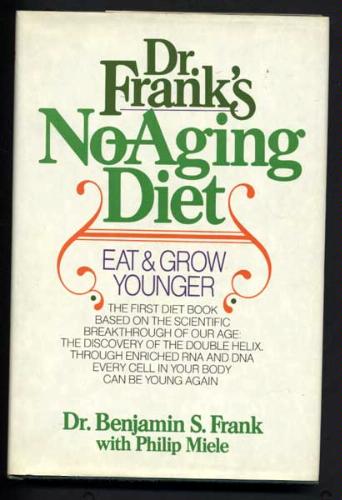
DIETARY ADVICE FROM DR. BENJAMIN FRANK’S NO-AGING DIET
Dr. Frank devotes the first chapter of Dr. Frank’s No-Aging Diet to providing examples of “walking miracles,” i.e., people whose experiences using dietary nucleic acids make them living testimonies to the power of high-RNA diets. His next two chapters establish his basic theory of aging and how it relates to dietary RNA.
As I noted earlier, Dr. Frank essentially describes how aging is caused and accelerated by loss of energy (as ATP or adenosine triphosphate) in cells. Dietary nucleic acids boost the body’s production and supply of ATP, thereby improving cellular function and extending life, as well as bettering a person’s quality of life (14–23).
Dr. Frank stood little to gain financially from sharing his knowledge about dietary nucleic acids. That is, apart from book royalties and minor fame as an author. Moreover, he had no ties to any products or the fishing industry. Yet, it is clear that he felt it was important to translate his theoretical and experimental knowledge into practical recommendations from which everyone could benefit.
DR. FRANK’S NO-AGING DIET, A.K.A., “THE FISH DIET”
Dr. Frank presents his actual “No-Aging” diet in chapter four. He lays down “12 rules” in this chapter (26–27). The first four rules involve consuming seafoods.
His first rule: “Four days a week, eat a three- or four-ounce can of small sardines.” The second rule is to have salmon (fresh or canned) as a main course one other day of the week. Rule three is having shrimp, lobster, squid, clams, or oysters as a main course on another day. Rule four is eating a different type of fish on the remaining day. That makes eating seafood de rigueur seven days a week!
Dr. Frank’s diet is often referred to as the “fish diet” or even the “sardine” diet. And that’s for good reason. Consuming seafood daily pretty much amounts to a fish diet. Here’s your weekly menu: Sardines four times, salmon once, non-vertebrate seafood (e.g, squid or shrimp) once, and then another kind of fish. That’s an extremely high frequency of consuming sardines and other types of fish even for seafood lovers.
Not to mention the boredom factor. Fish fillets, steamed fish, grilled fish, baked fish, seafood salad, sushi, etc. There are many ways to prepare it, but it’s still fish. Don’t get me wrong. I enjoy seafoods. But maybe once or twice weekly, not daily. And I’m careful to obtain wild-caught seafoods that are responsibly caught and/or harvested.
That’s getting harder to do even though certifications from organizations like the Marine Stewardship Council (MSC) are increasingly available. As I mentioned, the problem of overfishing remains. There also exists the real possibility of genetically modified fish (which already exist) contaminating wild populations. That would be a big loss for biodiversity among many other problems, including potentially adverse health effects.
ARE FISH DIETS REALLY DESIRABLE?
There are other critical considerations to consuming fish that go beyond obtaining high levels of nucleic acids.
Consider daily news about mercury- and chemical-tainted fish, ocean oil spills (think BP), radiation contamination of ocean waters (think Fukushima), and other sorts of adverse environmental impacts on ocean fish. Not to mention overfishing and depletion of many types of oceanic species.
Reality intrudes. I’m not convinced eating fish daily is desirable either for human health or the environment. In fact, I’m not sure most people today would be willing to follow a fish-based diet even if there weren’t contamination issues. (Nor would it be good for their health or the environment if they did.)
That’s not to fault Dr. Frank. As he says, “the diet works.” But back in 1976 the oceans weren’t quite as overfished or as polluted as they are today. Moreover, the level of awareness of these issues wasn’t where it is now. But even then, how many people (besides fishermen) could be expected to maintain a fish diet? No doubt, a few people stuck with it.
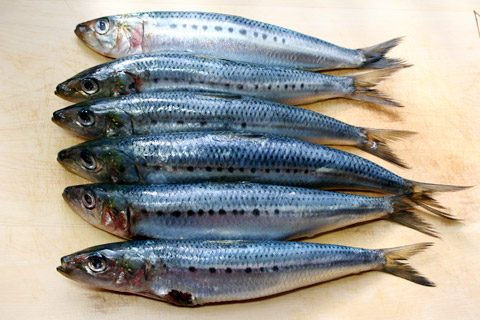
Today’s issues of overfishing and contamination beg the question of whether we have the knowledge necessary to manage fish populations. Apparently, science is discovering that populations of fish species (even sardines) thought to be plentiful are vulnerable to severe population declines. These may be cyclical, but overfishing could be enough to push these populations over the edge.
The graphic below shows the decline of one genus of sardines, Sardinops. There are other sardine genera (e.g., Sardina, Sardinella) now accounting for a majority of the global catch, but this data indicates that overfishing can contribute significantly to population decline.
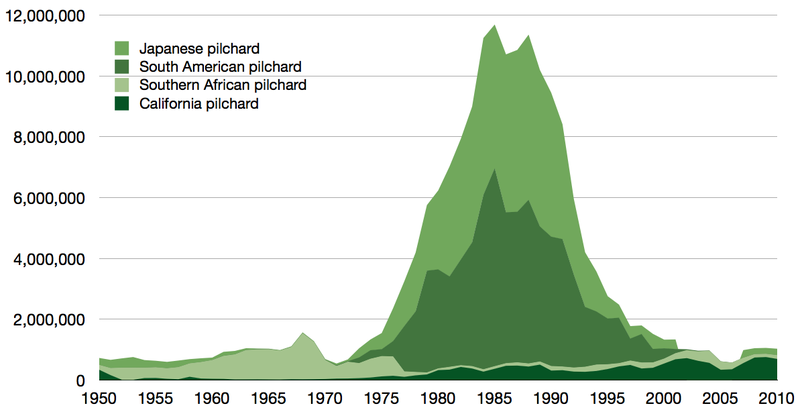
Note: The situation may be somewhat different for certain aboriginal peoples (e.g., Eskimos or Polynesians) whose traditional diets are high in fish and other marine foods. For such peoples, consuming seafood-rich diets may be more of a choice than in the past. Yet, for many it remains a way of life despite global overfishing and contamination with pollutants as varied as heavy metals (e.g., mercury) and radiation throughout the Pacific Ocean from the Fukushima nuclear plant.
RULE FIVE
Then there’s rule five: eat calves’ liver once per week. It turns out that calf liver and other organ meats (like chicken liver, beef heart, etc.) provide high levels of dietary nucleic acids. Dr. Frank points out that organ meats are ideal to consume (in addition to the basic fish diet), especially when compared to muscle meats (like steak or chicken breast), which are not significant sources of nucleic acids.
Certain people enjoy organ meats. I can’t say I enjoy them regularly. It is notable that organ meat consumption has declined for many years. Perhaps due to low demand, they are cost-effective foods in terms of how much RNA they provide for their price. (I routinely see $2.99 organic chicken livers at my local natural foods market. That’s per pound.)
Organ meats contain lots of dietary RNA. But liver, for example, is a detoxification organ. Unless you know the source is pure (or you don’t mind taking your chances), it would be wise not to overindulge. Think free range, organic, cruelty-free, and sustainably raised.
RULES SIX TO EIGHT
Rule six is to eat beets or beet juice once or twice per week. Rule seven is have a side dish of lentils, peas, lima beans, or soybeans once or twice a week.
Except for maybe soybeans (i.e., it’s hard to find them non-GMO these days), rules six to eight are simple to follow for most people. Unless you dislike beets or lima beans (butter beans). Personally I relish beets and beet juice, and most types of beans.
Beans are in fact among the highest foods in nucleic acids. That’s why Dr. Frank includes them in his list. If you don’t like seafoods or organ meats, beans can be your “go-to” food for RNA. Plus, there’s lots of variety among beans. They’re inexpensive, easy to obtain, store well, and readily available organic. You can even grow your own. I often grow tepary beans here in southern Arizona.
Speaking of beans, Dr. Frank reserves an entire chapter in the book to discuss vegetarian option for the no-aging diet. I’ll talk more about that later.
Rule eight is to eat at least one of the following daily: asparagus, radishes, onions, scallions, mushrooms, spinach, cauliflower, or celery. Most of these vegetables provide dietary nucleic acids. Others (i.e., cauliflower and celery) contain substances supporting the body’s utilization of RNA or other important nutrients. Most people can eat at least one of them daily.

RULE NINE
Rule nine is to take one “strong multivitamin after any meal” every day. This is an important rule for Dr. Frank. His insistence that individuals take a high-potency multivitamin shows that he was ahead of his time, as several authors have noted, including Dr. Ward Dean.
I don’t find Dr. Frank’s insistence of multivitamins to be outlandish. In fact, if anyone could see the benefits of high-potency multivitamins, one might expect it to be a molecular biologist like Dr. Frank who saw firsthand in the laboratory and with his patients the beneficial effects vitamins exerted on their health.
We at HPDI applaud Dr. Frank’s understanding that high-potency multivitamins can be important for health. We have pioneered a system of daily supplemental nutrients we call foundational formulas that include multivitamins. Click here to learn more about the HPDI system of foundational supplements.
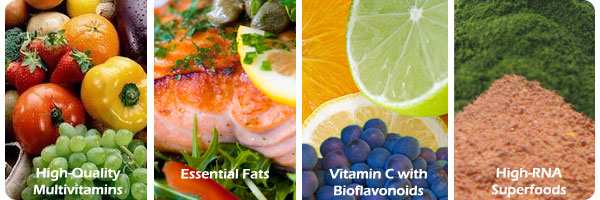
Dr. Frank was ahead of his time in other ways, too. For example, he makes a dietary recommendation to consume organically grown foods:
“…to be on the safe side I would avoid foods that are chemically grown and prepared. Chemical fertilizer use depletes the soil of trace minerals which are vital to health. Other chemicals used in food preparation are not natural to the body and may be harmful. Besides, organic foods taste better” (28)
Suffice it to say that when reading Dr. Frank’s books, I come across a fair number of dietary recommendations that many people take for granted today as beneficial. Most of his recommendations in hindsight were ahead of their time given how far outside the mainstream they were back in 1976.
RULES TEN TO TWELVE
The final three rules involve daily intake of fluids. Dr. Frank advises to drink a glass of fruit or vegetable juice (rule 10), two glasses of milk (rule 11), and four glasses of water (rule 12). I personally find water and vegetable juices easy to drink daily. Milk? Not so much.
Dr. Frank emphasizes fluids while on diet because high nucleic intake potentially can acidify the body and create problems with acidosis, including acidifying body fluids. Maintaining high fluid intake ensures the body stays pH balanced and/or more alkaline. Dr. Frank states that you can fall off the diet once in a while, but that fluid intake should remain high. So fluid intake is important when following a no-aging type diet.
That’s it. Just twelve simple rules that encompass the complete dietary approach to obtaining nucleic acids for their rejuvenating health benefits.
VEGETARIAN OPTIONS
To his credit, Dr. Frank understood that vegetarians require their own version of the no-aging diet that could provide high levels of dietary nucleic acids from vegetable sources.
He devotes chapter 13 to providing “A No-Aging Diet for Vegetarians.” The vegetarian version of the no-aging diet essentially replaces fish and seafoods with legumes as they main source of dietary nucleic acids.
The basic rule is that each meal must include at least one of the following combinations: 1) grains with milk products, 2) legumes (e.g., beans, peas, lentils) with grains, and 3) nuts and seeds with legumes.
Dr. Frank also separately lists nine additional rules for strict vegetarians who consume no fish. These rules center around consuming additional quantities primarily of the vegetables he already mentions in the regular no-aging diet. That is, more asparagus, mushrooms, beets, and greens (e.g., collards, spinach, and turnip greens).

He notably includes a recommendation to drink at least two glasses of milk daily. Milk is not high in dietary nucleic acids, but Dr. Frank must have felt it would provide additional amino acids that could not be provided well by vegetables.
I don’t see precisely why Dr. Frank considers milk to be vegetarian, but back in 1976 I suppose vegetarians might be presumed to be “ovo,” “lacto-” or “ovo-lacto” vegetarians. At least much more so than today, when strict vegetarians do not consume milk or eggs. Indeed, veganism has become a viable option for many individuals interested in consuming a 100% plant-based diet.
Dr. Frank is careful to explain that a therapeutic-strength multivitamin is an “absolute must” for vegetarians, especially given their needs for B vitamins, and particularly vitamin B12 (75).
BUILDING YOUR OWN HIGH-RNA DIET
One of the handiest features of Dr. Frank’s No-Aging Diet is the table in Chapter 14 titled, “Make Up Your Own No-Aging Diet.” The table (“Nucleic Acid Content of Foods”) estimates the approximate amounts of dietary nucleic acids in a variety of foods based upon their purine content. It presents relative amounts numerically terms of milligrams per 100 grams (at least that makes the most sense given the availability of accurate data about dietary nucleic acids today).
The table shows at a glance that chicken livers provide 402 mg of RNA, canned sardines 590 mg, and pinto beans 485 mg (per 100 grams). It is clear that legumes are nearly as plentiful sources of dietary nucleic acids as fish and organ meats. However, the specific types of nucleic acids are not listed.
RETROSPECTIVE MUSINGS ON THE NO-AGING DIET
Dr. Frank’s No-Aging Diet broke new ground. As I said, he was the first to turn laboratory results from his studies of nucleic acids into practical dietary recommendations anyone could follow. He deserves a huge amount of credit. Perhaps even a Nobel Prize.
In my opinion, the approach he presents remains revolutionary not only because Dr. Frank remains the only person ever to popularize a diet high nucleic acids. Think about it.
Nonetheless, Dr. Frank’s fish diet came and went. Certainly more fish are consumed today than in the 1970s or 1980s, and primarily for health reasons. Specifically, people see fish as healthier than red meats and as a good source of omega-3 fatty acids. Note that generally speaking this higher fish intake does not relate to interest in boosting intake of dietary nucleic acids or to having read or heard that Dr. Frank recommended fish for dinner. (His books are no longer in print and they haven’t been for decades, but they are available inexpensively through used booksellers.)
In any event, fish can be important part of a high-RNA diet. As noted, sardines are an excellent food. They provide the highest levels of nucleic acids of all animal foods. They also provide important vitamins (e.g., vitamin D), minerals, and essential fatty acids (omega-3s). Sardines are low on the food chain and therefore are lower in toxins like heavy metals and PCBs than larger fish, such as tuna.
WHAT DR. FRANK DID NOT KNOW
What Dr. Frank did not know is that there are foods providing higher levels dietary nucleic acids than fish. Specifically, chlorella.
Chlorella provides at least 10 times more dietary nucleic acids than sardines. No doubt Dr. Frank would be astounded by this fact, and would have had much to say about it. Unfortunately, the discovery that chlorella contains so much RNA was not widely known in the 1970s.
Dr. Bernard Jensen was the earliest popularizer and champion of chlorella as a source of dietary nucleic acids in recent times. He began researching chlorella in the early 1980s. He published his major work Chlorella: Gem of the Orient in 1987. Dr. Jensen had actually written a book on chlorophyll in 1973. But it took a decade before his interest in chlorella led him to visit a plant in Taiwan, and pursue the the study of chlorella.
Other researchers had shown interest in chlorella in the 1940s and 50s, but primarily for its nutritional content (proteins, fats, and vitamins) and chlorophyll. It was studied by Europeans during second World War as a potential food source, and later by US researchers (including Stanford Research Institute).
Melvin Calvin’s study of chlorophyll in chlorella led to his discovery of the process of photosynthesis (specifically the Calvin Cycle), and he won the 1961 Nobel Prize in Chemistry. Yet, dietary nucleic acids were not a significant part of the research into chlorella. And chlorella was never significantly tapped in the West for its nutritional value.
By the 1970s, the greatest production was in the East Asian nations, primarily Japan and Taiwan, where it was recognized for its nutritional value and healing capabilities.
In recent years chlorella has becomes something of a sensation in the health food and raw food communities. And there is evidence that it is going mainstream, much as it already has in places like Japan, where up to 60% of the population takes it daily.
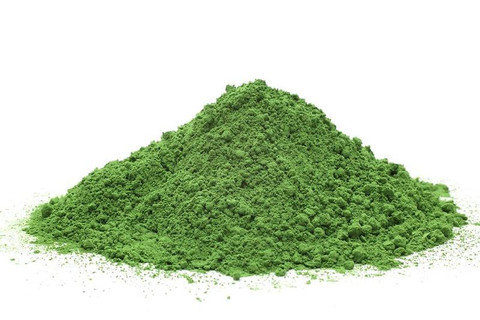
SOME CONSIDERATIONS ON CHLORELLA
The benefits provided by chlorella are similar to those provided by other high-RNA foods and superfoods. I have discussed these at length in other blog articles and product pages. Certainly not all nucleic acids are the same, and to some degree different types of nucleic acids provide their own unique benefits. We at HPDI believe, as did Dr. Frank, in a dietary approach that emphasizes foods over formulas that provide organ-specific types of nucleic acids.
In any event, chlorella provides extremely high levels of nucleic acids. It is a great food to have available. We have found that nothing beats chlorella for pure nucleic acid power. That is, we respect its capacity to provide RNA at therapeutic levels.
We found that chlorella has a few drawbacks. First, it’s amazingly high nucleic acid content combined with its chlorophyll content, and the unique capacity of its cell wall to latch onto toxins (like heavy metals) makes it an excellent detoxifier. In fact, the cell wall of chlorella is a powerful detoxifier all by itself independent of its nucleic acids. In some ways, this characteristic is a double-edged sword (so to speak).
The unique combination of nucleic acids, chlorophyll, and its cell wall creates the possibility that a person can detoxify too rapidly. Many people hold high levels of toxins in their bodies. Chlorella will pull out those toxins faster than almost any other natural food or substance. When the rate of detoxification exceeds the body’s capacity to process toxins, the result can be detox reactions. While these reactions may (or may not) last long, they can be uncomfortable. Like skin rashes, headaches, fatigue, or even fever.
This means it’s best to start taking chlorella in very small amounts, and then to build up gradually. But this can limit your intake of dietary nucleic acids at a time when you can benefit from higher levels of them were it not for the detoxifying effects of chlorella’s cell wall.
Then there’s the taste. It can be a little intense. A bit oceanic or fishy. I personally enjoy the taste of chlorella. I’ve had years to adjust to it. I’m already detoxified, although I often take chlorella (which is the main ingredient in Rejuvenate! original) to maintain my state of detoxification. I’ve also learned how to combine it with fruits, fruit juices (like lemon or lime juice), and other ingredients to create smoothies that improve its taste. This is especially the case when I desire a smoother, creamier texture or sweeter flavor.
I know plenty of people who can’t take chlorella due to its taste. Or who must moderate their intake. I also know certain individuals who just cannot stomach it. This may be due to taste or perhaps its detoxifying powers, or some other intangible factors.
Even I like to change up my superfoods. That is, despite the fact I enjoy the taste of chlorella, and I have developed ways to combine it (e.g., in smoothies and blender drinks) with many other ingredients from raw berries and fruits to avocados and nuts, I still enjoy other high-RNA foods and superfoods. These include Rejuvenate!™ superfoods, which are my favored means to consume dietary nucleic acids.
THE NEXT GENERATION: REJUVENATE!™ SUPERFOODS
Dr. Hank Liers formulated the Rejuvenate!™ line of superfoods in order to provide high levels of dietary nucleic acids in convenient, easily consumed powder forms that are highly pleasing to the taste. Other benefits include slower rates of detoxification, built-in complementary nutrients (like d-ribose, vitamins, and essential fats), and even a version for individuals who do not like greens.
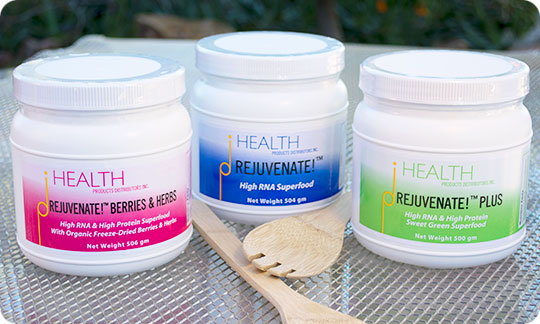
We initially formulated Rejuvenate!™ original as a means to leverage all the advantages of chlorella (60% of this formula) while including ingredients that increase the amount of dietary nucleic acids, as well as nutrients supporting their uptake and utilization. Rejuvenate! original is sort of this perfect mix of nucleic acids, greens (chlorella and spirulina), essential fasts, and supporting nutrients like d-ribose (which is the rate-limiting natural sugar for the uptake of nucleic acids, being the backbone of RNA).
Rejuvenate!™ remains our most potent high-RNA superfood in terms of the amount of dietary nucleic acids unit weight. This means it is highly cost effective, and with 42 servings per container it can provide a daily dose of 340 mg of dietary RNA for six weeks! It is most popular among our most health-conscious customers and “health foodies” and other purists who want maximum greens along with their nucleic acids. (Note that all Rejuvenate! superfoods provide 340–390 mg RNA per serving, but that the serving size varies to some degree.)
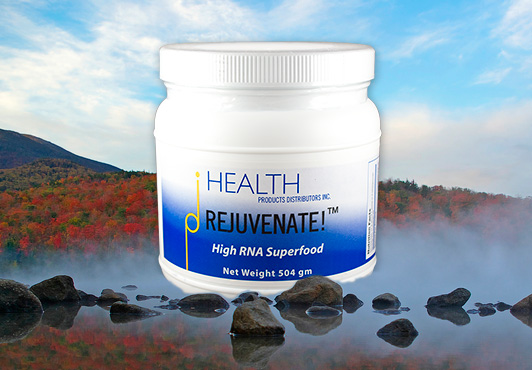
While Rejuvenate!™ original is most popular among our most ardent customers, we eventually discovered that for many people it could offer too much detoxifying power. That is, at least initially before their body adjusted to it. It is similar to straight chlorella in this respect. This issue combined with the the fact that for certain individuals the taste could be too strong sent us back into design mode.
Dr. Hank then formulated Rejuvenate! PLUS. It is about one-third original Rejuvenate! in its composition. This gives it greens and detoxifying power. But it moderates the rate of detoxification. It also creates a lighter texture and a slightly sweeter taste. Hence, we call it our “sweet greens” superfood formula.
Rejuvenate! PLUS has become our most popular superfood. It provides the same amount of dietary nucleic acids per serving as the original Rejuvenate! superfood. But it also offers high-quality plant protein, a built-in multivitamin (with coenzyme B vitamins), and additional synergistic nutrients. For all these reasons, it is our most balanced superfood in the opinion of many. I myself take it daily.
Rejuvenate! PLUS is especially enjoyed by athletes and individuals who participate in sports or outdoor activities. These persons notice a difference in their energy levels, endurance, recovery, and sports performance. See my article, “Dietary RNA for Athletic Performance” for additional information on the effects of dietary nucleic acids on exercise performance.
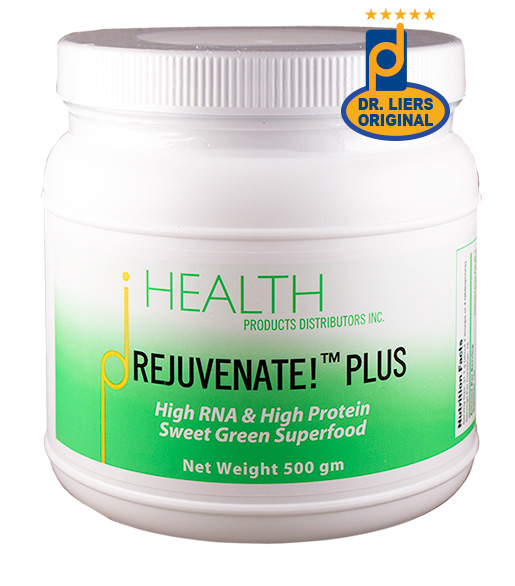
There for quite a while, we didn’t think there was any need to formulate additional superfoods beyond Rejuvenate!™ Original and Rejuvenate!™ PLUS. Most of our customers were highly satisfied with them. But we kept hearing from a certain segment of people that they wanted variety and from others we learned they couldn’t stomach any level of greens. So, we went back to the drawing board for more design work.
Hank then formulated Rejuvenate! Berries & Herbs. Rejuvenate!™ Berries & Herbs contains no greens. That’s a loss, for sure. But he made up for it by packing it with organic berries, which give it a very high ORAC value and act as powerful Nrf2 activators.
Secondly, this formula would have to taste great to satisfy the requirements of individuals who couldn’t take greens and/or who wanted variety. And it does taste great! In fact, most people tell us that it’s the best tasting of all the Rejuvenate! superfoods. I have to agree. While I swear by my love for Original and PLUS, both of which I take daily, I will not dispute the fact that Berries & Herbs trumps them when it comes to pure taste!
Hank then added an herbal cell support complex that’s hard to describe, but which is formulated to offer cells the highest levels of protection for optimal health. You can read the ingredients on the label to get some idea of how it works. Suffice it to say that the ingredients in this sub-formula include herbs known for supporting immunity, promoting normal growth patterns, and keeping cells in working order.
Rejuvenate!™ Berries & Herbs is a formula unto itself. That is, there is nothing like it anywhere. I don’t personally take it every day, but certainly more than several times per week. It also goes especially well into fruit-smoothies and blender drinks. I have no problem whatsoever downing delicious smoothies with PLUS and Original. But as the warmer weather approaches in Spring, I find myself reaching for good ‘ol Berries & Herbs. I even love it mixed directly into my fresh organic vegetable juices. How’s that for taste!
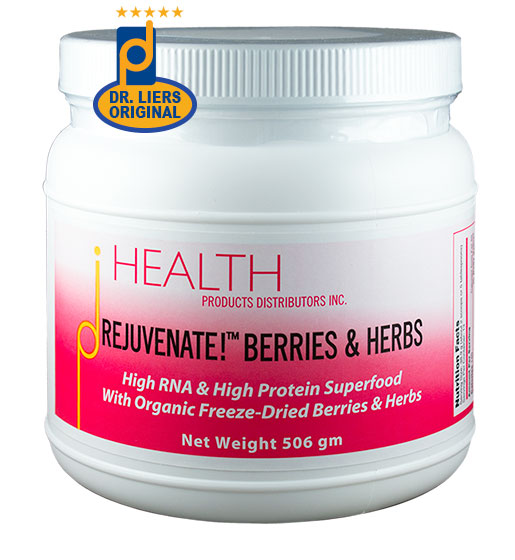
That’s my rundown on HPDI’s line of Rejuvenate! superfoods, which to this day remain the only superfoods formulated specifically to provide high levels of dietary nucleic acids for optimal health and healing, and even improve athletic performance.
I certainly hope you give Rejuvenate!™ superfoods a try if you haven’t already. They offer unparalleled benefits for your health, great taste, and an opportunity for you (and your loved ones) to gain real results from functional superfoods that do more than offer promises.
Click here to learn more about Rejuvenate™ superfoods.
FINAL WORDS
To say we at HPDI are grateful to Dr. Frank for his deep understanding of dietary nucleic acids is an understatement. To say that his understanding of nucleic acids is the foundation of our line of Rejuvenate!™ superfoods is not.
We can’t grant Dr. Frank a Nobel Prize posthumously. But we do wish he could see our Rejuvenate!™ superfoods, which we dedicate to his legacy. And of course, we hope he would have liked them enough to put them in his smoothies!
SOURCES & RESOURCES
The Problem of Age, Growth and Death. C.S. Minot. Putnam’s Sons, 1908.
“On the influence of nucleic acids of various origin upon the growth and longevity of the white mouse.” T. Brailsford Robertson. Australian J. Exp Biol Med Sci, 1928, 5: 47–67.
“The effect of yeast nucleic acid on the survival time of 600 day old albino mice.” Thomas Gardner. J Gerontol, 1946, 1: 445–456
“Prolongation of the life span in rats.” Max Odens. J. American Geriatrics Soc., 1973, XXI: 450–451.
It’s Okay to Eat Sardines…Right? Mother Jones Magazine. April 2012.
BOOKS BY DR. BENJAMIN S. FRANK
Dr. Frank’s No-Aging Diet: Eat and Grow Younger. Dial Press, 1976.
Nucleic Acid Nutrition and Therapy. Rainstone Publishing, 1977
Nucleic Acid and Anti Oxidant Therapy of Aging and Degeneration. Royal Health Books, 1977.
Nucleic Acid Therapy in Aging and Degenerative Disease–A Metabolic Approach with DNA, RNA, and Related Metabolites. Psychological Library, 1968.
ARTICLES ABOUT DR. BENJAMIN S. FRANK
Ribonucleic Acid Part One: A Highly Effective Anti-Aging Supplement by Ward Dean
Ribonucleic Acid Part Two: Review of Potential Anti-Aging Effects by Ward Dean
Ribonucleic Acid Part Three: Potential Therapeutic Uses: Review of Clinical Experience with RNA by Ward Dean
Revisiting a Scientist’s Work: New Studies Reinforce Older Ones…RNA Therapy May Slow Down Aging by Jeffrey Laign
SELECTED ARTICLES FROM THE HPDI BLOG
DIETARY NUCLEIC ACIDS – DR. BENJAMIN S. FRANK, PART 1 by Fred Liers, PhD
DIETARY RNA FOR ATHLETIC PERFORMANCE by Fred Liers, PhD
High-RNA Rejuvenate! Superfood by Hank Liers, PhD
9 Things to Know about Rejuvenate!™ Superfoods by Fred Liers, PhD
BE HEALTHY WITH REJUVENATE!™ BERRIES & HERBS by Fred Liers, PhD
Super-Tasty Morning Nutritional Drinks by Dr. Hank Liers & Fred Liers, PhD
Living with Radiation: Protection Starts Today by Dr. Hank Liers
PRODUCT REVIEWS
Rejuvenate! PLUS Superfood is High in DNA and RNA with sprouts, chlorella & more by Mike Adams
Product Review: Rejuvenate Berries & Herbs superfood is rich in RNA, plant proteins by Mike Adams
Superfood for Cellular Survival by Dr. Mark Sircus
MIKE ADAMS INTERVIEWS DR. HANK LIERS
Interview with Dr. Hank Liers, Part 1: Nutritional supplements and cellular energy
Interview with Dr. Hank Liers Part 2: High-RNA superfoods
Interview with Dr. Hank Liers Part 3: Chemical sensitivities and chlorella detoxification
Interview with Dr. Hank Liers Part 4: Reversing mass chemical contamination
Interview with Dr. Hank Liers Part 5: Superior nutrition for pet health


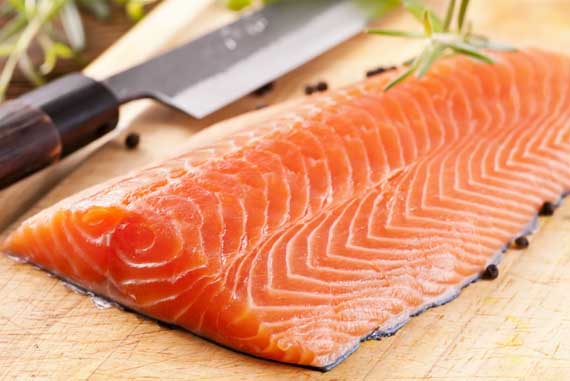
4 comments
I delight in, result in I found exactly what I was having a
look for. You’ve ended my four day lengthy hunt! God Bless you man. Have a nice day.
Bye
Thank you for this review of Dr Frank’s amazing pioneer research. This seems to be an “orphan” area in the anti aging community, probably because they , like yourselves have “new and improved” products (not to diss your company). I REALLY like your “udated” information on Chlorella, a product long ago touted by a remote viewer AKA “Dr Doom” who touted it as the “ultimate” (and perhaps only available) survival food. I personally have been “loosely” following Franks diet for about 40 years and can tell you it REALLY WORKS! I am now approaching 67 Y.O. and look to be in my 50’s and can’t attribute this to genes ( my siblings all look their bilogical age) so I must conclude Doc Frank had it “goin’ on” way back when…
Thank you for your insights. We too feel that Dr. Frank had uncovered a major healing modality back in the 1960s and 1970s. Although we certainly have “new and improved” products, we still strongly believe in and take daily our Rejuvenate products that contain RNA, Chlorella and Chlorella Growth Factor. In fact, our Rejuvenate! products continue to be best sellers for Our company.